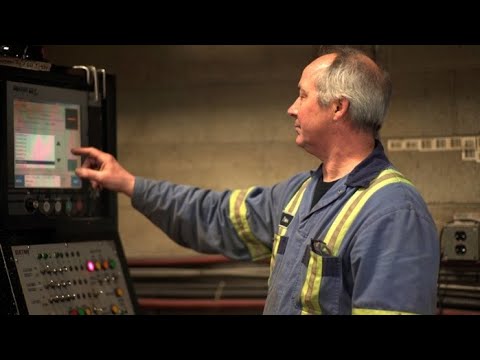Career Overview
People in this career set up and run metal-cutting machines designed for repetitive machining work. They also etch or chemically mill metal pieces.
Machining tool operators work in metal products and other manufacturing companies and in machine shops and perform a variety of tasks.
Job Titles
Duties
Machining tool operators perform some or all of the following duties:
- Study job orders and read blueprints to determine machining work to be done
- Set up and run machine tools to perform repetitive machining tasks, such as turning, milling, drilling, boring, planing, honing, broaching, grinding or other tasks
- Check the size of parts machined using micrometers, callipers and other precision measuring tools
- Prepare etching chemicals to remove unwanted portions of metal objects
- Perform maintenance on equipment and machinery
- May enter codes specifying speed, feed and cut of the toolpath for computer numerical controlled (CNC) machine tools.
Earnings
Earnings is income that workers receive in exchange for their labour. Depending on the type of employment, earnings can be in the form of wages (hourly), salaries (fixed monthly or annual) or self-employed earnings.
Work Environment
# Workers Employed
325% Employed Full Time
75%Key aspects of work in this occupation:
- Machining tool operators usually work in a conventional controlled environment such as an office, hospital or school
- This work produces enough noise to cause loss of hearing
- Work is done with equipment, machinery or power/hand tools that could cause an injury
- Work may involve chemicals that are harmful to skin or eyes, dangerous if inhaled or may cause a fire or explosion
- Work may cause harmful vibrations in the body
- Workers are exposed to small pieces of flying material and falling objects that could cause injury
Career Pathways
Experienced machining tool operators may become machinists or tool and die makers through apprenticeship training.
Related Careers
Occupational Interests
It’s important to understand what kinds of occupations align with your interests.
For more about occupational interests visit Skills for the Future Workforce > Characteristics.
Here are the top occupational interest(s) for this career profile:
Education, Training and Skills
- Some secondary school education is required
- College or other courses in machining may be required
- Several months of on-the-job training are provided
- Senior positions in this unit group, such as set-up operator, require experience as a machine operator
Education programs in B.C.
The following program areas are related to this occupation:
- Academic/Basic Upgrading

Skills
Every job calls for a certain set of skills. Knowing those skills is the first step in finding a good career fit.
Here, you will find the 10 most relevant workplace skills. Some are more important to achieving success in a certain career than others. These skills may come naturally to you or you may need to gain them through education, training and experience.
See the list of work-related skills below, ranked in order of importance for this career. Check out the list and see if this career matches your skills—take that first step!
Watching gauges, dials or other indicators to make sure that a machine is working properly.
Controlling operations of equipment or systems.
Conducting tests and inspections of products, services or processes to evaluate quality or performance.
Keeping track of and assessing your performance, other individuals, or organizations to make improvements or take corrective action.
Using logic and reasoning to identify the strengths and weaknesses of alternative solutions, conclusions or approaches to problems.
Understanding written sentences and paragraphs in work-related documents.
Giving full attention to what other people are saying, taking time to understand the points being made, asking questions as appropriate, and not interrupting at inappropriate times.
Considering the relative costs and benefits of potential actions to choose the most appropriate one.
Determining causes of operating errors and deciding what to do about it.
Being able to solve novel, ill-defined problems in complex, real-world settings.
Labour Market Statistics
Discover data, facts and information that have been gathered and analyzed. Learn about the characteristics of the economy and labour market in B.C.
Employment
Find out about employment types and trends by region and industry.
Employment
325Employment by Region







| Region | Employment | % Employment of this Occupation |
|---|---|---|
| Cariboo | 0 | 0.0% |
| Kootenay | 0 | 0.0% |
| Mainland/Southwest | 245 | 75.4% |
| North Coast and Nechako | 0 | 0.0% |
| Northeast | 0 | 0.0% |
| Thompson-Okanagan | 35 | 10.8% |
| Vancouver Island/Coast | 25 | 7.7% |
Labour Market Outlook
The B.C. Labour Market Outlook is a 10-year forecast of the expected supply and demand for labour in the province. It’s usually updated every year. The purpose is to provide British Columbians with the knowledge to make informed decisions on careers, skills training, education and hiring.
Forecasted Job Openings (2024-2034)
120Forecasted Job Openings
Forecasted Employment Growth Rate
Composition of Job Openings
Job Openings by Region (2024-2034)







| Region | Job Openings | Avg. Annual Employment Growth |
|---|---|---|
| Cariboo | Not available | Not available |
| Kootenay | Not available | Not available |
| Mainland/Southwest | 100 | 1.1% |
| North Coast and Nechako | Not available | Not available |
| Northeast | Not available | Not available |
| Thompson-Okanagan | 10 | 1.9% |
| Vancouver Island/Coast | 10 | 0.9% |
Industry Highlights
Learn about the opportunities in B.C.'s major industries, including employment trends, earning potential, locations of work and more.
Forecasted Job Openings by Industry
| Industry | Job Openings (2024-2034) |
|---|---|
| Manufacturing | 110 |
| Construction | 10 |
Resources
Resource information is currently not available.









